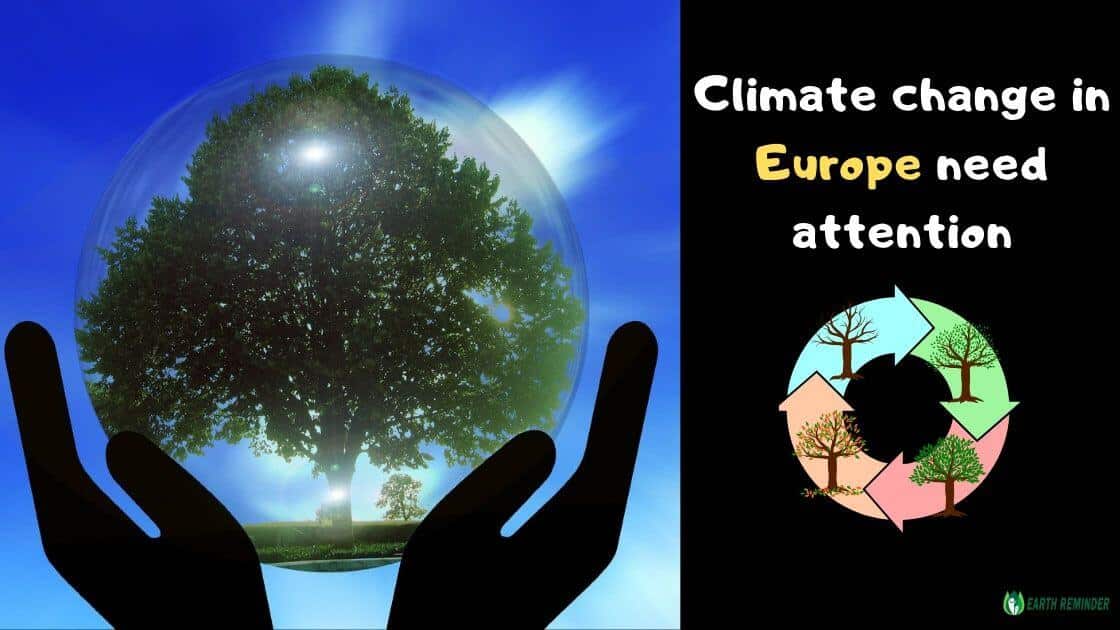Climate Change: Europe’s Condition ☀️
In this article we will look into serious climate change conditions in Europe.
Climate Change in Europe –

Climate change is having tremendous impacts on our planet, showing significant changes in weather conditions all around the world. For Europe in particular, 2018 was the most extreme year when it comes to unusual weather events. European winters have been extremely cold, whereas spring and summer have seen unusual heat and droughts. Although it’s too early to tell in which unusual weather is caused by climate change, climate scientists have highlighted the fact that climate change is only pushing in one direction: towards warmer temperatures.
Table of Contents
How Has Europe Been Affected by Climate Change?
A study by GreenMatch is mapped out unusual weather trends throughout Europe by looking into surface temperatures, sea temperatures, sea levels, and precipitation . The results have been illustrated in the map below, with 0 being the least affected, and 100 the most affected.
According to it, throughout the last few decades, Lithuania has been the most affected by climate change in Europe, whereas Iceland, has been affected the least.
Countries Most Affected by Climate Change in Europe
- Lithuania
Sea levels in Lithuania have risen by 4.46 mm per year between 1970 and 2015, which is relatively high compared to other European countries. Their sea temperatures saw an increase of 0.73°C from 1960 to 2014, whereas surface temperatures rose by 0.325°C. Finally, between 1960 and 2015, Lithuania’s precipitation saw an increase of 20 mm per decade.
- Finland
Sea levels in Finland saw a decrease of 4.26 mm per year. Due to the Fennoscandian land uplift, it is difficult to determine the extent to which this number is a result of climate change. The sea temperature, however, has increased by 0.73°C, whereas surface temperatures increased by 0.314°C.
- Latvia
Latvia’s results are very similar to those of Lithuania, with the exact same score on three of the indicators. The only indicator that differs slightly is the sea levels, with Latvia having seen a rise in sea levels of 4.02 mm per year between 1970 and 2015.
Countries Least Affected by Climate Change in Europe
- Iceland
In comparison with other European countries, Iceland saw a significantly smaller change in sea temperatures: an increase of only 0.208°C between 1960 and 2014. This increase is even lower than the global average of 0.327°C. The sea levels also saw a below-average increase of 1.31 mm per year. Furthermore, surface temperatures increased by 0.275 — which is quite average for European countries — whereas precipitation saw a relatively high increase of 35 mm per year.
- Greece
Greece saw only a 0.075°C increase in surface temperature per decade. However, the Greek seas became 0.706°C warmer between 1960 and 2014, which is quite high in comparison with many other European countries. Finally, sea levels in Greece rose by 2.01 mm per year, whereas precipitation decreased by 20 mm per decade.
- Norway
Even though Norway is the third least affected European country, they saw the highest change in precipitation: an increase of 37.14 mm per decade. Norway’s sea levels rose by only 0.25 mm per year, and the sea temperature increased by 0.439°C, which is below the European average. Finally, the surface temperature in Norway has been increasing by 0.275°C per decade.
Also check – Why Environmental Education is important?
How Has Europe Been Affected by Natural Disasters?
The World Meteorological Organization has highlighted several important indicators of climate change, such as drought, extreme heat, flooding, and extreme precipitation. Using such indicators has been considered a way to get an understanding of the influence that climate change has on such extreme events.
Even though it is not possible to directly correlate these extreme events to climate change, in order to still get an overall understanding of the climate conditions in Europe, GreenMatch has also looked into trends surrounding such extreme events. The map below shows the number of extreme events that have occurred between 1960 and 2019 in each European country.
Source: greenMatch
As we can see from the map, France has seen the most extreme events in Europe between 1960 and 2019. More specifically, France experienced a significantly higher amount of storms and floods compared to other European countries: 62 storms and 48 floods in total. On the other hand, Iceland, Finland, and Estonia only saw very few extreme events. Iceland, for example, only saw one extreme event since 1960, which was a flood.
Years by Years changes are getting bad in number, We should take necessary action to prevent further climate change.
As an Environmentalist, we want to thank GreenMatch for taking out a deep study and showing the world that climate change is real and it’s happening. Furthermore, To know everything in detail about it, Check out – “Climate change” article in detail.
If we “the people” will not take any action with respect to changes in the climate than our own future generations will suffer. We would like to guide everyone with true and positive motivation towards care for mother earth. We will also advice our readers to research by their own also before coming into any conclusion or taking any action.
Feel free to contact us for any addition and correction. Share this article if you like it.